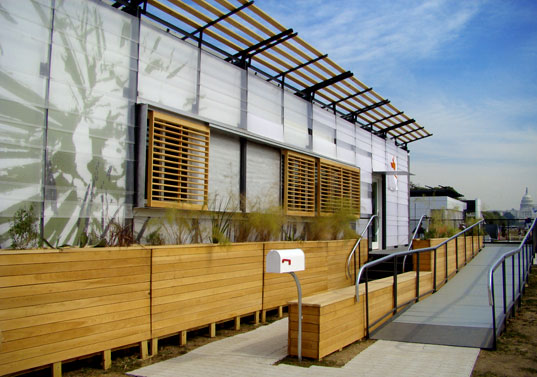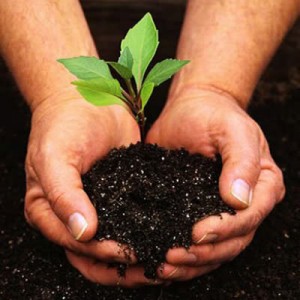Save Money And Be Eco-Friendly – 40 Tips For Your Home
June 10th, 2009 by admin At the turn of the century, Upton Sinclair helped our raise national awareness about the toxic nature of unregulated industry with his novel The Jungle. Today, people have recognized another toxic by-product of civilizations. The healing process, known as the green movement, has begun.
At the turn of the century, Upton Sinclair helped our raise national awareness about the toxic nature of unregulated industry with his novel The Jungle. Today, people have recognized another toxic by-product of civilizations. The healing process, known as the green movement, has begun.
However, the green movement requires more than just governmental regulations and industrial change. It also requires changes in every home in the world, and truly, in every person’s attitude toward environmental protection. If you want to add a little “green” to your home, read these forty tips toward creating a green home.1. Weather proof your doors and windows
Every air leak in your home represents an increase energy usage. For example, when cool air leaks out during the summer or when warm air leaks out during the winter, your air conditioner or heating system runs harder and longer. The end result is a greater use of electrical or natural gas energy. While many industries are showing more concern for the environment, most electrical producers must still use coal-fired plants and most natural gas producers must drill and destroy ecosystems. The less energy you consume, the more green your home becomes.
2. Using energy-efficient lighting
Energy efficient lighting in the form of compact fluorescent bulbs can save your home some money and also make it much greener. Compact fluorescent bulbs use less energy and last longer than traditional incandescent bulbs. (Incandescent bulbs are the round bulbs with a filament inside that have been used widely.) When you use less energy on your lighting, you reduce the amount that is required of electrical energy producers.
3. Turn your thermostat down
If your home is equipped with a programmable thermostat, then you are in luck. Program your thermostat to be at a green temperature, normally in the low 70s. Not only will you be more comfortable in a stable temperature, but also your heating or air conditioning unit will not work nearly as hard. That will save you repair and energy costs, and help the environment by eliminating all the “green” costs of repair and energy overuse. Turning down your thermostat just one degree will save you around 4% of your heating costs.
4. Giving air conditioners a tune-up
Air conditioning units, especially newer units, can be much more efficient if given a tune up every two years. Have a technician ensure that your air conditioner is running in tip-top condition, and your pocketbook and sense of environmental ethical responsibility will thank you. This is a great tip for those without the funds to buy a newer, more efficient air conditioning unit. The tune up will allow owners of older models to make environmentally conscious decisions without breaking the bank.
5. Installing low flow taps and showerheads
Do you know what the gallons per minute (GPM) measure of your faucets, showerheads and toilets are? Older homes are often fitted with very high flow rate water fixtures. Not only will the increase amount of water wastage cost you more money, but it does a number on the environment as well. Because more processing is required to meet water demand, companies must build new water treatment facilities. When companies have to build to meet demand generated by waste, the environment suffers.
6. Insulating the water heater
Insulating jackets for water heaters and pipes are not only cheap, but also effective. The idea is simple – cover your water heater and adjoining pipes in insulation, and less heat is lost to the surrounding air. The end result is that the water heater does not work as hard, does not use as much electricity or natural gas, and saves you money. In turn, the environment will thank you as companies stop building more plants to meet wasted demand.
7. Regulating the water heater
Is the water coming out of your taps scalding hot if you turn the heat on all the way? Did you know that your water heater could be regulated to the point that full heat at the tap becomes a comfortable temperature? Regulating your water heater is a lot like programming your air conditioner thermostat. The water heater will only heat water to a specified temperature, and then stop. It requires much less energy to heat a water heater to 120 degrees than 180, and the former is much safer for children and adults alike.
8. Installing a tankless water heater
The tankless water heater is a modern green marvel. The way it works is that water is pumped through a heating device that gets very hot, very quickly. That way, a tank of water does not have to be kept at a constant hot temperature all day long, but rather water is heated on demand (a tap or showerhead is opened). Tankless water heaters are also great for the home – they are tiny compared to tank varieties and can be easier to install.
9. Planting greenery
This one is a no-brainer. When you plant decorative shrubs and trees, you are essentially installing oxygen generation machines in your yard. They are beautiful, decorative and by definition, environmentally friendly.
 10. Buying ENERGY STAR products
10. Buying ENERGY STAR products
To achieve ENERGY STAR certification, appliances must meet very stringent specifications for energy use and wastage. Basically, ENERGY STAR devices are the greenest ones around because they have been designed with the certification in mind (and therefore the green movement too). Sure, they cost more money from the get-go, but in the long term these devices will reduce your energy expenditure and resulting costs.
11. Getting a blower door test
Blower doors are cool tools used by energy use specialists to help homeowners determine the amount of leakage in their homes. The contraption is set up in a door of your home while all other doors and windows are closed. Then, a calibrated fan blows a specified amount of air into the home and a pressure sensitive device records the effect. If air is leaking, then the pressure device will not register the normal amount of pressure. After this test, a technician can tell you how large your total leak, or the sum of the areas of all leaks, is. Bigger leaks lead to greater energy use and more negative environmental externalities.
12. Using Low-VOC products
Volatile organic compounds or VOCs are molecules that are toxic to humans and/or the environment. Many paints and cleaners use formulas that contain VOCs. Common substances containing VOCs are mineral spirits, paint thinner, oil and waterborne paints, and solvent based cleaners. What is important to note is that VOC formulated products are intended to let VOCs drift into the air. To make a long story short, releasing toxic fumes is not only unhealthy, but also unethical. The green movement has prompted many companies to prepare green or low-to-no VOC formulations of their products. Ask store clerks for these products when buying paints and cleaners.
13. Using proper insulation
Any way you can keep heat and cold in your home makes your home more efficient. Insulation is your way of wrapping up your whole house to keep the desired temperature inside. Homes with poorly installed (or absent!) insulation require more work from air conditioning units, which in turn uses more energy. By insulating your home correctly, you can save some money and environmental harm. Get in contact with a contractor to discuss insulation.
14. Composting
Such is the cycle of life: it is born, it grows, it dies, it is eaten, and it turns to dirt. Thankfully, humans have taken charge of this life process in the form of composting. The idea is simple – throw all your organic, non-toxic garbage into a big dirt pile and let a multitude of worms, insects and fungi feast on it. The leftover excrement and debris is nature’s most natural and potent fertilizer. It is literally packed with all the nutrients that the original banana peel left behind!
15. Use rainwater
While this idea may not sound pleasant, it can at least be practical. Put a big barrel underneath all the gutters attached to your home. When it rains, the gutters pour water into your barrels. Use this water to water your gardens or wash your outdoor furnishings. Do not use this water for drinking, however. It could contain unsafe levels of bacteria or roof debris.
 16. Planting a garden
16. Planting a garden
Do you know the plight of the commercially grown vegetable? It begins life as a seed, harvested through unnatural hybrid production. It is then planted in ground saturated with unnatural fertilizers, which will eventually run off into streams and rivers. As it grows, it is watered by aquifers which are unnaturally pumped dry. It is then harvested and transported with machines that generate waste carbon and pollution. I am guessing that being a vegan/vegetarian does not feel as soul-satisfying right now.
The natural alternative to the farming debauchery is to grow your own garden. Slap your own compost on your own dirt, and work it with the strength of your back. Albeit, if you grow beans you may be guilty of generating waste methane, but the amount will not be nearly as damaging as what is created by combines and trucks.
Worried about having “green” food for winter? Revive the old lost art of canning.
17. Buying energy efficient windows
The window is an intentional design flaw. It is a controllable hole in your home that will let all manner of heat and cold escape at the possibility that the air outside is comfortable enough to tolerate. If you must have windows in your home (proponents of fresh air and sunshine exist?), then install energy efficient windows. You will save money and use less energy.
18. Using recycled roof shingles
Have you ever lifted a bunch of shingles? If you have not, it is around eighty pounds. That will cover only a fraction of a small roof. Yes, you have hundreds of pounds of crap on your roof that is designed to protect you from all things falling. There are hundreds upon thousands of waste rubber tires floating in landfills that would make perfect trampolines to keep hail and the neighbor kid’s ball from damaging your rafters. Case in point, buy recycled.
19. Use your ceiling fan in the winter AND the summer
If you’re lucky enough to have a ceiling fan, did you know if you reverse it’s direction it will blow warmer air down into the room making your hose feel warmer.
20. Landscaping with drought-resistant plants
This is a tip to protect you from being counterintuitive. Planting a ton of environmentally friendly shrubs, trees and plants is a great leap forward in making your home green. Just make sure that your greenery does not create a bigger problem than you started with because it requires more water consumption. Using drought-resistant plants will be a surefire way to make sure your new green investment stays green.
21. Planting shade trees
Sure, newer air conditioners use less energy, and are more efficient, and blah, blah, blah! There is a much more low-tech solution to the problem. Plant a shade tree next to your home, and the resulting shade will naturally cool your house. Just make sure to plant it a safe distance – you do not want to have to replace your foundation when tree roots crack it or your roof when falling limbs destroy it.
22. Install recycled flooring
You walk all over your flooring. Why does your flooring have to be made of brand new materials? Consider using recycled flooring, that way when Fido uses the floor instead of the fire hydrant it will be an act of the green movement!
23. Using modern appliances
Newer is not always better, but when speaking green it is. Stone Age appliances use more electricity and resources because people back then did not have a clue that their actions were destroying the future Earth. Modern technology and philosophy have resulted in more efficient appliances that use less energy. Less energy usage is environmentally friendly.
24. Keeping air filters clean
For those who have never changed their air filter, the air filter in your air conditioner unit is just behind that grate that sucks in air. Its purpose is to remove particles from the air which will cause the unit to malfunction or cause your allergies to flare. Most filters get filled with dust and debris as months go by, and all filters require washing or replacement after a manufacturer specified time period. To reduce the environmental costs of air conditioner repair or allergy clinic visits, replace your air filter often with a quality filter!
25. Using aerators on taps
Most taps come with an aerator these days, but if a recent plumbing fiasco resulted in a lost or destroyed aerator, invest in one. They are cheap devices that add air to the water running from taps. This increases the volume of the running water, so it becomes more effective in rinsing and washing. The result is less water wasted in doing the dishes.
26. Banish dripping taps
A tap dripping at just one drop per second will waste 10 gallons over the course of a week.
27. Buying recycled paper products
Printer paper, newspapers, toilet paper, paper towels – each product uses a precious resource, trees. There is big potential for saving the planet by using only recycled paper products. Less logging means less expended energy and fewer fallen trees. The result is cleaner, more abundant oxygen rich air.
28. Reduce the consumption of plastics
Plastics are a unique material due to their construction. They are made from petroleum and therefore require all the environmentally unfriendly techniques associated with petroleum exploration, collection and refinement. In addition, petroleum-based plastics release toxic compounds when burned. This is a common problem when rubbish must be burned.
29. Turning off your computer
Yes, having your computer fired up and ready to surf when you wake up each morning is glorious. However, you can save a lot of energy by turning it off at night. If shutting down is too inconvenient for you, use the hibernate feature in Windows.
30. Using soft furnishings and curtains to retain heat
Soft cloth curtains and drapes retain heat. Therefore, before winter hits, hang your soft curtains to keep heat in the room. This is especially important for homes with poorly efficient windows.
31. Consider solar panel electrical sources
This tip requires a big investment, but the savings are huge. Solar panels are expensive, a few thousand pounds for an average home. But when your electricity bills are a fraction of their previous amount, you will be relishing the investment. Not to mention that solar energy is environmentally friendly to the extreme.
32. Using roof coatings to retain heat
Companies sell special roof coatings that are applied to the underside of your roof which can retain heat in the winter and repel heat in the summer. Once coated, your roof will be just as efficient as your double paned windows and ENERGY STAR compliant dishwasher.
33. Install magnifying solar lights
Magnified solar lights are like tiny skylights, but magnified so the incoming light will illuminate an entire room. Rather than using artificial light to illuminate interior rooms, have these installed and use solar energy without the expense of buying panels.
34. Having “green inspection” tests
Like the blower door test, green inspector companies can send technicians to evaluate your home’s efficiency. They can provide customized tips to save energy in your home.
35. Conserving water
Remember the Earth Day campaigns from the 90s? Having been a kid at that time, I remember that I am supposed to turn off the water when brushing my teeth. There are many ways to conserve water that are common sense. Follow them and enjoy a greener home.
36. Conserving electricity
Once again, common sense dictates that when an appliance is not being used, it should be turned off. This includes computers, video games, televisions – anything that uses electricity. Saving energy can be as easy as being responsible with your electronics. Remember, the energy you use may not be the direct culprit of environmental harm. Rather, the waste energy you consume prompts companies to build more plants to meet future demand. More plants make more waste.
37. Adjusting the refrigerator
If you can freeze POP-ICE in the fridge portion of your refrigerator/freezer, you need to adjust the temperature. By putting the temperature at a level that will provide food protection and less energy use, you can take a proactive green step for your home. It is normally as easy as turning a dial – look at the top of the inside of your fridge.
38. Line drying clothing
Another no-brainer is using wind power to dry your clothing rather than an electricity-guzzling dryer. Just keep in mind that especially humid days will make line drying difficult. Don’t worry – people have been line drying in their homes for decades.
39. Closing the fireplace damper
If you are noticing an especially large amount of air leakage from your home, but don’t know where the leak is, check the fireplace damper. Close it when not in use!
40. Using the smallest pan while cooking
An often-overlooked tip, larger pans require more energy to heat. If you use the smallest possible pan, you will use less range top time and therefore less total energy. Basically, if you are cooking Ramen noodle soup for one, don’t use your largest stockpot.





 0
0